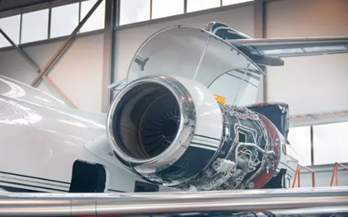MRO Transmission Overhaul Flow: From Warranty Firefighting to Safe Predictable Throughput
- Joe Brauch
- Aug 19
- 3 min read
Major Rotorcraft MRO (eight‑figure annual revenue; 13k+ components/year)
Turnaround Time −5 days | Rework −26% | Same Headcount
Executive Snapshot: A Head Start on Today’s MRO Challenges
Challenge: Industry-wide, MRO 2025 data shows turnaround times slipping across nearly every component category, with supply chain volatility and labor shortages driving costly rework and warranty events. We faced those same pressures years ago in our rotorcraft transmission shop: chip-outs on first run-up, late QA catches, long and variable TAT, and heavy internal rework that pulled senior mechanics off the line for warranty dispatches while customer aircraft sat Out-of-Service.
What we changed: Before these trends dominated the headlines, we attacked the root causes with a lean flow redesign including; value stream mapping, 5S, and a workflow layout to cut motion and waiting. We moved QA hold-points upstream to catch defects at sub-assembly build-up, cross-trained technicians to flex at constraints, optimized shifts, and commissioned a dedicated transmission test bench. We also updated their Repair Station Quality Manual/145 procedures, for 100% post-overhaul functional verification.
Impact: Within four months, average TAT dropped by five days, rework and warranty rework fell by 26%, and throughput steadied into a predictable cadence. The result was higher first-pass yield, fewer schedule disruptions, improved customer relationships, and the ability to keep our best people focused on planned work instead of firefighting. The very levers the MRO 2025 report now cites as critical to reversing industry-wide TAT and quality declines; proof these results are achievable without adding headcount.
The story
The call nobody wants: A customer installs an overhauled transmission and, on first run‑up, the chip detector illuminates. Another warranty event! To keep the aircraft flying, a field team is dispatched or the unit ships back for re‑overhaul, while the shop falls behind on current work and the customer's aircraft sits idle.
Week 1 — See the work: We built a Value Stream Map (VSM) and walked the line with the crew. The Gemba Walk coupled with a Spaghetti Diagram showed hundreds of feet of unnecessary walking for kits and tools and equipment. Quality Assurance was catching issues after component assembly that should have been stopped at sub‑assembly build‑up. Furthermore, there was no dedicated transmission test bench, so many of the defects first surfaced on the customer's aircraft after installation.
Weeks 2–8 — Fix the system, not the people.
Workflow layout & zones: Re‑arranged mechanic benches into a U‑cell with unambiguous clean/dirty boundaries to prevent part cross‑contamination.
Point‑of‑use kitting & 5S: Two‑level kitting carts (now/next), shadow‑board tooling, and labeled FIFO lanes cut motion and search time.
QA at the right point: Added independent inspections (hold‑points) at component build‑up and pre‑install, moving verification upstream.
People & cadence: Cross‑trained techs to flex at the constraint and leveled release (Heijunka) so the line stopped starving and flooding.
Weeks 9–16 — Full verification: We commissioned a dedicated transmission test bench and updated the Repair Station Quality Manual procedures. Every unit now received a full post‑overhaul functional check before release. The impact was immediate.
What changed (and why it stuck)
Before
Some defects appeared only at customer run‑up → warranty rework and travel.
Late QA catches drove costly internal rework and TAT variability / delays.
Mechanics hunted parts/tools; morale suffered.
Customer's aircraft sat Out-of-Service for days / weeks awaiting overhauled components.
After
Transmission Overhaul TAT: −5 days on average.
Rework & warranty rework: −26% (cleaner first‑pass yield).
Throughput & on‑time delivery up—steady cadence, fewer stop‑starts.
Morale & safety up—less firefighting, less part movement, clearer ownership.
Mechanic: “Kits and checks are where we need them. We’re building, not chasing.
”VP Operations: “We stopped flying our best people to fix avoidable problems and put predictable hours back on the schedule.”
Controls that hold the gain
Visual management: hour‑by‑hour boards and FIFO lanes.
Quality system updates: Updated RSQM/145 procedures reflecting hold‑points and bench release criteria.
5S audits & standard work: quarterly cell audits; kit accuracy checks.
Capacity discipline: leveled release rules (oldest ready first) and a daily tier‑board to surface blockers.
What you can copy tomorrow
Move one QA check upstream (sub‑assembly build‑up).
Pilot a cell + two‑level kitting carts for your highest‑volume gearbox family.
Level your test‑bench queue and publish new unambiguous guidelines.
Start a 10‑minute tier‑board—open tags, hold‑points due, parts staged.
Want similar results? Optimal Aviation Solutions helps MROs turn downtime into revenue by fixing flow and verification at the root, no slide‑deck theater, just shop‑floor changes that crews accept and auditors respect.
👉 Book a 60‑minute Operations Excellence Snapshot (baseline of TAT/rework, a constraint map, and a 90‑day plan you can run—or ask us to co‑pilot).




Comments